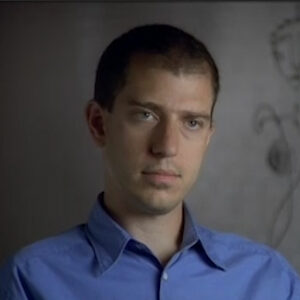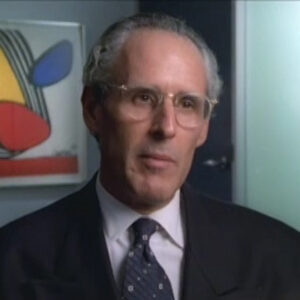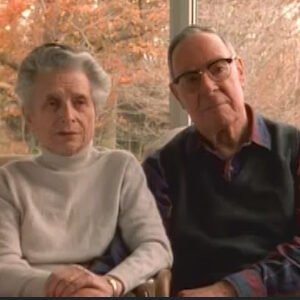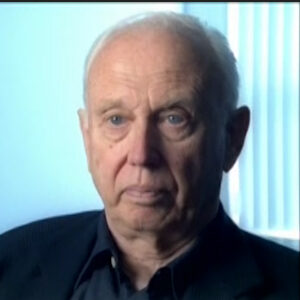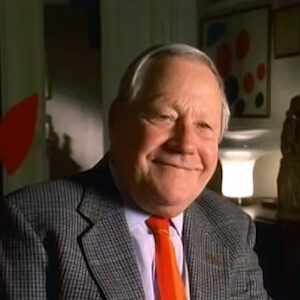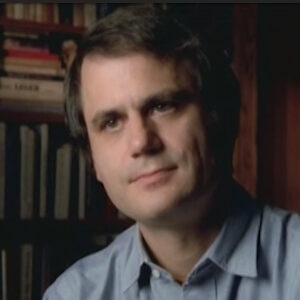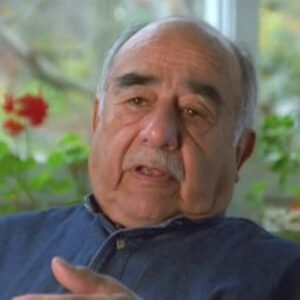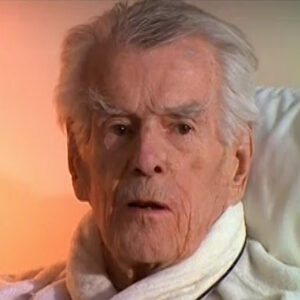Michael Brenson: Well, he’s, uh, he is a unique figure in 20th century art. He brought certain ways of making ways of thinking, ways of creating into the artistic landscape that had never really existed before and made it possible for many different artists to move in in directions that that would have not been possible. And it’s very hard to imagine, quite apart from the joy. I mean, the sheer joy that his work and his career given people, he made it possible for many sculptors simply to move in directions to develop possibilities that they just couldn’t have done otherwise.
Interviewer: Can you see hundreds of Calter pieces? Can you tell your experience? What is the experience of viewing a Calter piece.
Michael Brenson: Well, I think that it’s, uh, you know, he’s an artist who affects you as a child. And when you’re young and you go to museums or you go to people’s homes, you it’s not always easy to to respond to what you see. And the particular kind of magic that he had affected me as a kid. And I had this feeling that what he was making in these particularly the mobiles that he was speaking to me, that that I was an important audience. The children were an important audience. And as such, I think he has an ability to bring whole generations of young people into art in a way that very few American artists, other American artists can. And on top of that, I think there are many individual pleasures that I get out of that I love. I think what he did with the syntax of sculpture is very original. And I get a lot of pleasure out of watching what what his hand did with form and watching what the shapes on those on those mobiles do and watching the kind of balances that he set up. He really made a kind of formal inventiveness, something that was quite wonderful in itself in a way that very few other abstract artists have been able to do.
Interviewer: What did he do with the syntax of sculpture?
Michael Brenson: I just think I think he you know, the way he put something in relation to something else, the way he put one of those organic shapes in relation to another shape or the way he bend the wire. There’s a language there. I mean, he had this tremendous freedom and originality in the way he approached every aspect of the formal language of sculpture and was constantly sort of testing it and reinventing it through his own imagination and curiosity. So therefore, you see relationships that that you really don’t see in many or you don’t see it till much later with people like David Smith and Anthony Carrow. And yet he was he was twisting things this way and that and he was balancing the weight this way and that and he was changing the way that you could see a line and the way you could respond to a body. And he was doing this very early in the century.
Interviewer: Talk about static versus not static and solidity versus what was what was there before Calter? What did he bring?
Michael Brenson: I think a lot about that in relation to his father. I think his father in many ways was fairly typical of a kind of very skilled, monumental sculptor who work with very large forms and very massive forms. And then you have this kid come in and really third generation within the family. And that whole idea of monumentality got turned almost on its head. So that that that massiveness was something he didn’t he never accepted throughout his whole life. He sort of he really opened up the mass and and made everything white and kept it light and and also took the whole element of labo, of sculpture, sculpture. And that had been a fairly important part of all monumental sculpture before. I mean, you look at his father’s work, you have a sense of of the work that went into it and said the essence of the mass of the stone. And Calder clearly wasn’t interested in any of that. And and just brought into it a kind of lightness and resistance to mass. And that was really, you know, you really you really see t the difference between a 19th and 20th centuries that way.
Interviewer: OK. OK.
Michael Brenson: You know , if I can just elaborate a little bit more. I think he brought into the sculpture and also his particular reaction against his father and the kind of work that was done in American sculpture in the 19th century. I think he did have this profound reaction against self-importance of any kind. And there there definitely is in this kind of monumental stone sculpture when it’s not absolutely first rate kind of self-importance to it. And I think he reacted against that sort of body and soul from the beginning of his work almost to the end.
Interviewer: Do you think that makes him any less serious?
Michael Brenson: I think the notion of seriousness and Calder is an interesting question. I think he was so determined not to be that on the almost not to to to put himself within the context of a certain image of an artist that I think sometimes he didn’t. He. He never put any pressure on you. He didn’t put any pressure on the people who was looking at who who looked at his work. But I also dont think he put any particular pressure on scholars and critics to think about his work in certain ways and I think there maybe he he got into a little bit of well, he went for the first time in 1926 and he went then fairly regularly for fairly long periods and then fairly regularly for the rest of his life. Finally building a house for himself. And in a studio in Sashayed, it became very important. And he went at a good moment. He went in 26 Paris said it was still very much the center, the recognized center of the art world. It was still work where most of the great artists were. He had really just come out of the war and sort of emerged from the shadow of the war. And it had surrealism had just kind of happened in 1924 was the beginning of it. So that there was there was this whole new emphasis on the possibilities of the of the imagination, of the unbridled imagination and what it could do. But surrealism still existed at the same time as as cubism and in a kind of remnant form. And and then all sorts of all sorts of threads of abstract art that had come from from what’s now Eastern Europe and Holland and elsewhere. So it was it was by far more of a melting pot in terms of trends, ideas in European and European and American art, by far more of a melting pot than any place else.
Interviewer: He’s only 28 years old. He really , I mean there is a style, but he’s obviously still emerging. Do you think he’s that self-possessed that says I’m not going to do the surrealist thing. I’m not going to go on, do his own.
Michael Brenson: One of the things that is most striking to me about Calder is his self-assurance. I think from the very beginning, he had the confidence to do whatever he wanted to do. There was this belief in him that that that whatever he did artistically was OK. And that’s the kind of confidence that I’m not sure really existed in American art before. I think it’s very important that that he comes he’s the third generation of artists. So he didn’t have to defend a certain he didn’t have to defend art in America, as many first generations have. And he grew up in in an artistic and an environment where art was almost second nature. It was natural. And this allowed him to take certain things for granted that other artists couldn’t. And I think in part, it gave him this extraordinary freedom as a self-possession, self-assurance to do exactly what he wanted to do. And I think he had this extraordinary confidence in itself almost from the beginning. I don’t think I don’t think that that anything intimidated him.
Interviewer: Do you know the story of Mondrian, going on to Mondrian studio in 1930 where he reacted to everything painted red the primary color. He comes back and he starts working. Can you relate that shock that might have caused. He called it a shock.That’s the first time he starts to actually doing abstract art.
Michael Brenson: I think he was also he was very struck by those spaces. I mean, in Mondrian studio, I think that the. Particular shapes and and lines on the wall in those primary colors. Which is which he used along with black and white throughout.
Interviewer: Can you start again because I was talking at the same time you were and tell us Mondrian.
Michael Brenson: Well, he went to visit Mondrian on the router de pas. I think it was 1930. And Mondrian was was a very he was a very well-developed point in his career and with with the ideas of abstraction that we now identify with him completely from in his mind. And. And as always, with Mondrian and the it was kind of no difference between art and life. The way he painted was also the way he lived and and the structures, the spaces of his of his paintings and in a sense came to life in that little apartment on the route de pas. And I think I think it was partly the totality, the integration of the two that that struck Calder for whom making toys, making toys, a certain notion of performance than making jewels. And everything else he did were always so integrated with the with the notion of art. And I think he was very struck by the by the kind of spaces, not just the colors that Mondrian use, the primary colors, the black and white, but also the spaces between them on the walls. And and he remarked how how important this certain notion of structure and that notion of of of speciality was to him. And and. And there’s no question in that form in which it was completely integrated with life. I think it gave him a kind of confidence to develop these spatial ideas that at that point really helped him.
Interviewer: So he moves into wire sculpture. Had that really been done before like that.
Michael Brenson: Well, I think there there was certainly a good deal of of of interest in these new materials like wire, like iron, like steel in the first part of the century, particularly as it manifested itself in constructivism. But maybe nobody did it as as playfully and as freely and as much marked by the you know, the particular sense it mark so openly by the sensibility of a particular imagination and by the touch of a particular hand. So it’s almost as if he took these ideas that were very much in the air through constructivism and then and then partly grasping what mirro people like Muro had done were they brought a certain lightness to this idea of drawing in space and then in this kind of synthesis that he always seemed to be capable of without trying. He began then to in to invent and develop these wire forms in space that had his own particular playfulness and joy.
Interviewer: They were one piece of wire, very complicated, yet very simple and neurical at the same time. Caricatures, but insights into someone. Can you talk about insights. Josephine Baker.
Michael Brenson: Well, they had this he did have this very special relationship with materials. I mean, he could what he did with the wire in his hand. It was almost like a sort of drawing with with his body. And and it had it easy to do to it, although he wanted it to seem to be easy, even when it was difficult. And, uh, and it you know, it had the spirit and that could become could could come out of him and also capture the spirit of a personality. And he was interested in these performing personalities like Qiqi, like Josephine Baker, who were very much in vogue in Paris at the particular time and drawn to these theatrical person eyes. And I think probably in some odd way even identified with him. And maybe it’s the it’s the quality of that identification that enabled him and in his own particular language to capture such a an essential part of their personalities.
Interviewer: So he starts making circus figures and he starts performing this circus, which today I don’t think we really understood. Can you explain why.
Michael Brenson: When you say that we don’t we don’t understand it. How do you mean?
Interviewer: It looks nice. It looks quaint, but I don’t get it was the hot night out in Paris. That circus critics, which was at that time an art form reviewed it. These people, that’s what they did.
Michael Brenson: Well, I mean, it’s important to keep in mind that there was fairly strong reactions against what conventional notions of art were. That what World War One did to notions of of seriousness and conventional art throughout a society. So people were looking for new ways of of thinking and that sort of reinventing and we imagining and making art maybe in ways that that that that didn’t look like art in a traditional sense. It didn’t it didn’t look like painting and sculpture and form, but nevertheless, had this kind of had this kind of spirit and inventiveness and freedom. I think the freedom, the freedom of of that circus in what was called the dead were extremely important. And then keep in mind, the circus had been an essential theme in French modernist art since the middle of the of the 19th century through Impressionism. And they’re gone. I think if someone like Ceraso Circus, the circus was almost identified in some way with with modern life and for the artist. I think these circus performers who were who were performing who were doing tricks in public, but who were in some ways outsiders who were sort of inside society, but really outside at the same time. I think it all contributed to make the circus a very important idea. And I think if you look at Picasso’s rose period circus figures, you really get a sense of of that identification with the performative and also outsider aspects of circus life.
Interviewer: I want to get into the mobiles before I don’t remember. What do you think of some bronzes even. Figures, some abstractions. Do we care about those?
Michael Brenson: I think Calder did very little in that period. That I’m aware of, that isn’t interesting. And I think that I think I like his wood sculptures, too. I think. I think that there is a kind of connection with the material. And I and I love the animals that he managed to do there. But I think, you know, in those kind of works, the subject is always of paramount importance. And I think on some level Calder or always wanted to deflect, deflect it a little bit so that when you when you thought about his work, you didn’t think so much about what it was about, that there was a.
Michael Brenson: Which one of you?
Michael Brenson: Well, the drawings he did for the police gazette are quite wonderful.
Michael Brenson: The drawings he did for the National Police Gazette are really quite wonderful, and they are animals and they’re already he’s he was very much the works of someone who had a student. Just a wonderful feeling for animals. But this feeling of sort of realizing, of realizing what he did through line and through the simplicity of line, that he could really capture the the the spirit and personality of these creatures. And and so I think the the those drawings really gave him a kind of shot in the arm. And also, I think the fact that he did them for the the National Police Gazette, which is and the way those drawings were integrated in an odd way within within the society itself, is it there’s an anecdote in relation to that that I think is worth mentioning, and that is that he did Ralph Robinson was the secretary of the National Police Gazette and Calder told the story of going out in the country with him. And Robinson was a sometime artist. And they went out to a farm and Robinson set up the easel and he put down the canvas and he started painting the farm. And Calder took his canvas and and nailed to a tree and started to paint the portrait of Robinson. But he was using an old canvas so that there was an image of a of a nude underneath it. So he painted the portrait over the nude, which somewhat mortified Robinson. But Calder like to tell that story. And I think his absolute determination to do things his own way and to do things in a way that it never seemed institutional are really reflected very strongly in that particular story.
Interviewer: Good story. We need those anecdotes. Any others, please bring them up. Let’s go to the development of actually, I’d like to talk about that for Josephine Baker’s. It’s really his move in the 30s towards abstraction. The last one is much more lyrical, abstract by any means. Can you talk about his move towards abstraction?
Michael Brenson: Maybe sort of. We we might need to talk a little bit more about that. Or maybe just go on to the next question. I’ll see if I can come back. Come back into that.
Interviewer: Rustling Look, if you cut, say, cut. No, no, no. Cut. Take two.
Interviewer: Tell us about this move towards abstraction that he was doing Jospehine Baker for over a period of 4 years.
Michael Brenson: Well, there he did have something of a synthetic mind and he was responsive to a great deal of what was going on around him. And in Paris, in that particular period, you do have you do have surrealism. You do have the kind of second and third generation of cubism, and you do have a very strong presence of abstraction that became increasingly strong, stronger around 1930 for various reasons. And I think maybe a response to the to the Depression might have made the kind of frivolity or playfulness of the 20s to a lot of people seem slightly indulgent. So I think I think there were a couple of issues there. I think one was was the way in which he he he he had a way of assimilating. Whatever was going around, going on around him at an abstraction had become increasingly important. I think that probably Mondrian also gave him the notion of of what could be done with a certain kind of with a more of an art or something more austere, something a little bit more severe. And then I think he saw in abstraction, also a way of of developing a sort of purifying and developing at the same time his own formal language. It gets it gets it gets increasingly distilled formally without losing any of its expressive dimension. But I think it also it definitely becomes somewhat less playful in an environment in which in which Europe was in a great deal of trouble.
Interviewer: So on comes the mobile. This what we now see completely ubiquitously throughout the world that I would have thought came from ancient Egypt or Mesopotamia or something like that. Blows my mind. Would you say, he invented an art form?
Michael Brenson: It’s it’s hard to know how else to describe it, because there really wasn’t anything quite like that before. And the way of suspending these these forms in space and and moving and all sorts of directions and these wonderful kinds of equilibriums, that he was able to establish it really they really weren’t like anything anyone else was doing. And I think it’s safe to say, even though he didn’t give the name mobile mobile to it, that’s Duchamp’s name, that it really is his art form. I don’t think there’s any question about that.
Interviewer: Did he develop the mobile and then just make thousands of them and not push the form? Was there a form to progress through there.
Michael Brenson: I think that there was and I think he did develop keep developing the idea of the mobile over a period of of 25, 30 years. And and did keep investigating its all of its possible permutations. And I think at the point where he felt that it become it it becomes somewhat so clearly repetitive that he could not go on. He really stopped and then went ended the stables and and basically left the mobile behind altogether.
Interviewer: Let’s talk about something else. What was going on? I mean, he actually starts to stabiles small in the 30s. He hopes that people will give him commissions to put in their gardens. It doesn’t happen for ten or fifteen years. What was sculpture at that time? How did where do you think stabiles has come from in the head like that.
Michael Brenson: Let’s sort of keep talking.
Interviewer: I think that this slender figure, it’s not stone. It’s not bronze. Maybe we should talk about the bronzes first then. He did some bronzes. Can you respond to them and say the word bronzes?
Michael Brenson: Again, I sort of like to leave that one because.
Interviewer: So what what do you think of the stabiles?
Michael Brenson: I’ve I have a less feeling for them than the mobile. Some very. I see. Certainly the the stabiles are they’re grounded. The mobiles are in space. And I and he wanted something that would really be firmly attached on the ground and that people could move to spacially in a way that was somewhat compatible, although complementary. Compatible with.
Interviewer: Tell us about this first big show of his.
Michael Brenson: Well, I think it’s I think it’s significant that he was he was the first artist of his generation, maybe the first American artist this century to have a broad based reputation. That’s to say not only in Europe, in the United States, but also in Europe. And in bar, Alfred Barr had put him in two major shows that cubism and abstract art and also Dora, I think, fantastic on surrealism in 36 and 37. So he had a degree of success. That is it is interesting to try to keep in mind, given the fact of the kind of art that he wouldn’t that he made. And I think the fact that he was able to, to some degree, assimilate many of the important developments in Europe in such a vernacular, American style, and with such an American spirit really made him a natural to be given the kind of of of importance and visibility that he had in this in this country. And then when he had a retrospective at the Museum of Modern Art in 1943, right in the middle of the war. When I think it’s his the spirit of his objects were particularly welcome anyway, it was it was quite logical that that it could happen.
Interviewer: In the 50s, he gets to start to make larger pieces. Are they as successful as smaller pieces.
Michael Brenson: In my mind, they’re really not.
Interviewer: Can you give me the whole.
Michael Brenson: I think the I the stabiles? I like the idea of the stabiles. I like the idea of of developing these these enormous metal sort of constructions of silhouettes in public places that the public that can move around and completely integrated with them and in a way that they’re completely friendly and reassuring and yet somehow somehow become markers in in the architecture, in the landscape. I like the idea of those very much. But I’m not sure how successfully he realized them. And because there is a lot of them, a certain kind of inertness to me. He never gets that that that poetic movement that he got in in the mobiles. And I think sometimes he was he was reaching for it. And so I think to stay BYLES or in terms of the history of public art in this country, they’re important. They’re important for the relationship with the audience. They’re important for the for the way in which he transforms Free-standing sculpture and opens it up. But I would probably be up to other people after him.
Interviewer: Tell us about it first you saw Calder.
Michael Brenson: I lived in Paris and from 75 to 82 and I used to see Calder, I think I probably saw him the first time before that because I was already toward the end of his life. But I was very surprised when I saw him because I thought from the nature of the work that he was doing that he would be. He would be thin and athletic and almost a little bit like a ballet dancer. And I saw this bear of a man sort of walking down the street and walking down in a very determined way. And and his body was was even tipped a little bit. So he was he was being propelled forward by some kind of force inside him that I didn’t really understand, but that a man who had this this this physical mass and this weight could make the kind of work that he made. I was amazed by that.
Interviewer: Talk about about this question of influence. Was he strongly influenced by other artists?
Michael Brenson: I think that that that was an important issue for him. And one I think I think I think the issue of influence was important for him. And I think like a lot of other conventional ideas of art, he wanted he needed to find some way around that. And so I think that he he absorbed information very quickly and in a way that artists do, because artists can be and can be in a room, they can see things, they can pick it up and you can come into their work right away without even thinking about it. But I think it was important for influence to be absorbed that way. In other words, for it not to be a situation where he sits down and he thinks about Miro or he thinks about Picasso, that somehow it enters into what he’s doing much more quickly, much more automatically, much more naturally. And I think it’s very important there to point out that the Calder was a worker from the basically from the beginning to the end of his life. You want he worked like workers work. He did it. He he had breakfast. He went in a studio. He had an idea that he wanted to realize. He took a break for lunch. Then he worked throughout the day after he was a problem solver. So that I think by setting him by setting himself these problems and by working on these problems without thinking about influence directly, he made it possible for all these influences to to enter his work and become part of his work without becoming an issue in his work. So that you can you can look at what he does and and maybe, you know, Miro will come to your mind at a certain point or poor Clay or even Picasso. But it’s not an issue when you don’t really think about them. It always somehow really remains sort of immediately and totally Calder.
Interviewer: Can you talk about he worked in many, many different mediums and it’s all Calder. Can you talk about this thread perhaps. Do you see it?
Michael Brenson: Everything was Calder or everything he did had his particular stamp of personality about him. I thought, you know, he had this curiosity about materials. And I think that there were certain things that he he could get from different materials that he could get from wood and he could get from bronze. But most of all, he could get for metal because it was a particularly modern material and it had a particular suppleness, particularly when he was working with Wire that the other materials didn’t have. But at all. It all went through his hand. It all went through his mind and and it all had the stamp of his particular identity.
Interviewer: Let’s cut for a second. He dealt with humor. It was his work was often very light, lyrical, but is that not serious and sometimes gets accused of not being serious.
Michael Brenson: Well, I think I think that he gave humor a place, and importance, possibility in American art, that that it may not have happened before, particularly this kind of playfulness that would become really important for people later on. I think where the issue becomes sort of difficult is that I think maybe he was the first artist to make children a primary audience and to make people feel that you that he was someone coming out of the depths of modernism in a way. But you didn’t have to understand all that. You know, with most other artists, there’s a certain amount of of intellectual foundation that you need to have in order to be to understand what Mondrian does. I think even to some degree, what Miro and Clay do. With Calder, that wasn’t a factor anymore. What a child. How a child responded to Calder that was every bit as valid as the way an art historian or philosopher responded to a Calder. But on top of that, what an intellectual would say wasn’t particularly relevant to the to the kind of experience that that that a younger person or an adolescent or anyone could have in front of that work. So he put a certain kind of ownership. He gave a certain kind of ownership of of his work to people who were not intellectuals. I mean, two common people. There’s something very democratic about that. And I think there’s something quite intentionally I don’t say anti-intellectual, because that’s not true, but non intellectual away. And I think he pushed a lot of of the intellectual community to the side and didn’t privilege them the way a lot of other modernists did however unintentionally. In the process made I mean, that’s where the notion of of seriousness comes in and made a lot of these people feel as a result that maybe the work wasn’t as serious as as a lot of these other artists.
Interviewer: Switching gears again because we’re almost finished. He took out a full page ad against the war in Vietnam in 1966 all by himself. He did posters. He was very free with. Can you talk about the other activities that he did and how that measured up to Calder.
Michael Brenson: Well, I think I know he was he was a humanist and and he was he had a a degree of sympathy with a strong feeling of the kind of injustice. And in his own way, he did react against it. And I think make his position clear. But it was not an activist position. And I think maybe this comes back to a little bit to the notion of seriousness, too, because most of the really significant American artists between the wars and I’m thinking about people, particularly David Smith and Stuart Davis and a lot of the abstract artists, were also activists. And it wasn’t just expressing their sympathy for a kind of inhumanity, but they were much more they were much more connected with unions and they were much more out in the street. So I think here, too, I think I think it’s humanism is clear. But I think he’s a little bit peripheral. I know a little bit off to the side and wasn’t and wasn’t going to get involved as totally as I as a lot of the other major artists of his generation did.
Interviewer: How do you think he should be remembered?
Michael Brenson: I think he should be remembered as great poet. As maybe one of the great sculptor poets, as a as a poetic engineer, as someone who who brought in audiences that are only now beginning to be completely respected in the art world and brought kind of possibility that would enable artists as different as as Mark di Suvero and Anthony Carroll and Red Grooms and Claes Oldenberg to move in directions that they that they might otherwise have not been able to move into.
Interviewer: I think this is three, we’ll be three.
Interviewer: Influences.
Michael Brenson: I think that the fact that he assimilated influence the way he did. That’s to say he seemed to have done almost automatically immediately. Also means that he doesn’t call attention to the people he comes out of and he doesn’t really call attention to himself within certain traditions. I mean, if I if I contrast him, let’s say, with David Smith, who was who was eight years younger and where you can see him struggling with Picasso and Julio Gonzalez and Jacque Ametti at a certain point of his life, that also places him. And that also puts the pressure on people looking at his work to think about him in relation to a larger tradition, I think Calder bypassed that. I don’t think he was particularly interested in it. And I think it’s one reason why it’s he doesn’t put pressure on you to think about him historically necessarily or in terms of ideas, in terms of of the life of the mind, the way other great sculptors of the of the 20th century did.


